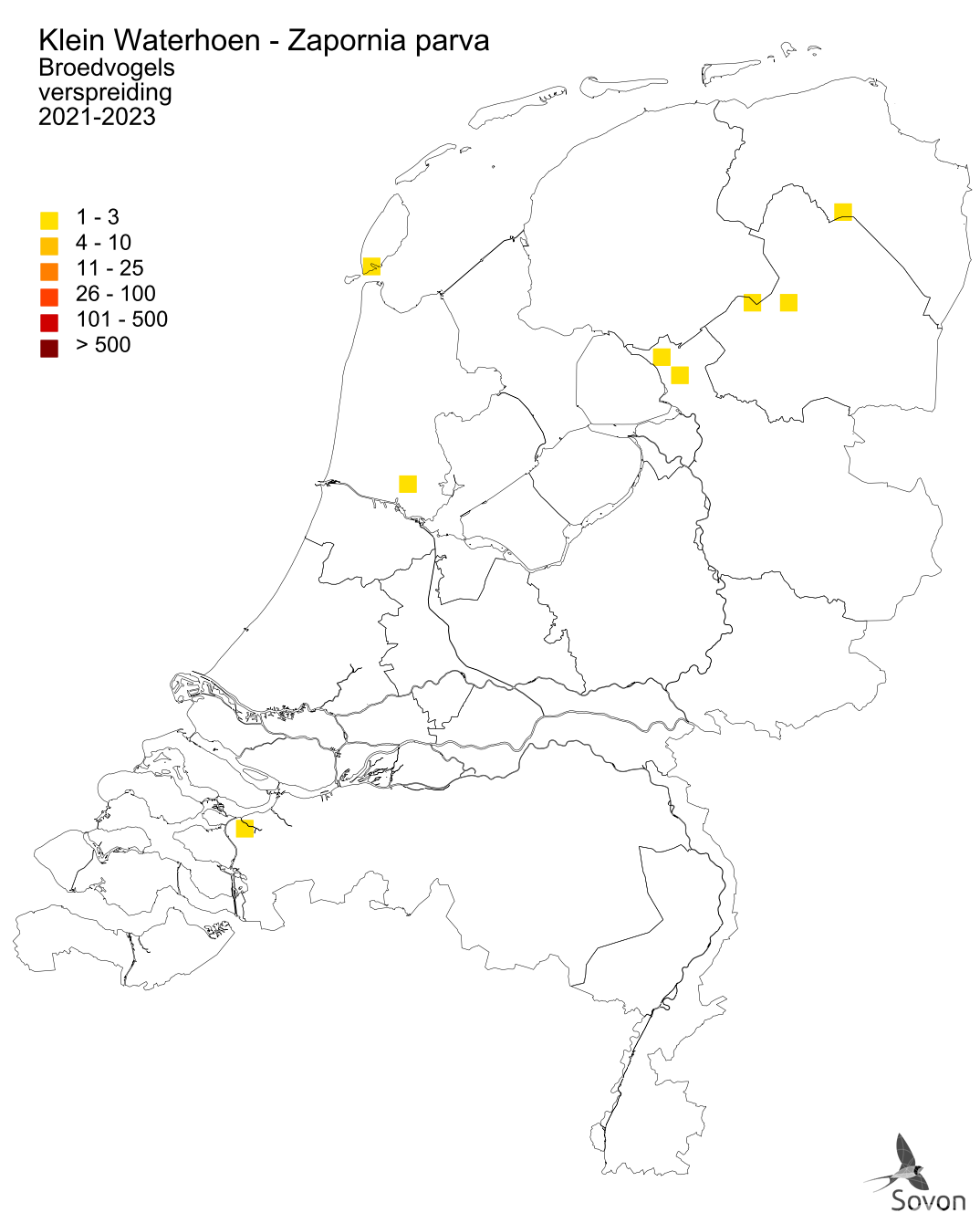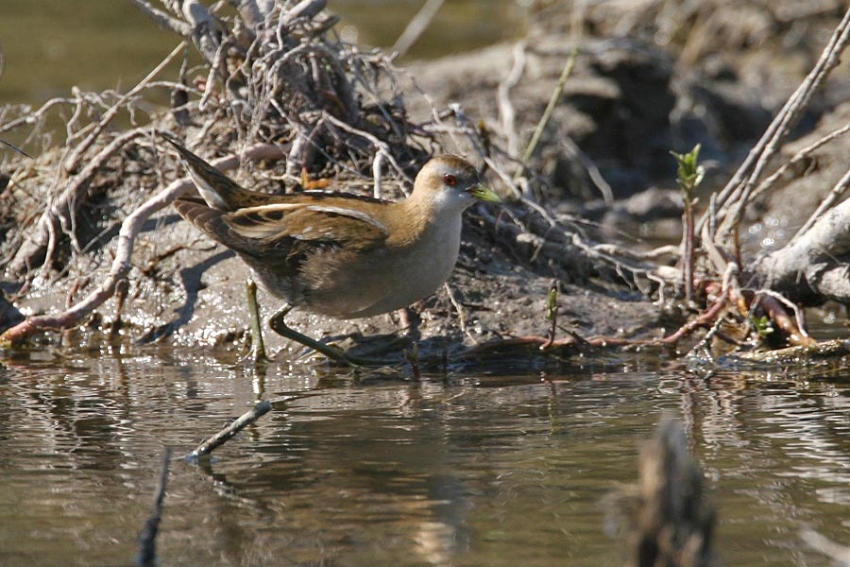Distribution and trends
Distribution

This map is derived from the annual survey of colonial and rare breeding birds. For each atlas square of 5x5 km the most counted number of breeding pairs is given.

This chart is based on the Atlas of the Dutch Birds (1987), an estimate of the numbers present is given for each atlas square of 5x5 km.
Population trends
Not enough data.
Breeding success and survival
Not enough data.
Seasonal occurrence
seasonal pattern
This chart is based on the Atlas of the Dutch Birds (1987). An indexed number per month is shown. First, the numbers are averaged over all counting years per atlas block for each month, the result of which is averaged over all atlas blocks for each month.
Occurrence description
Buiten broedtijd
Waarnemingen worden beoordeeld door de Commissie Dwaalgasten Nederlandse Avifauna (CDNA). De meldingen beperken zich nagenoeg tot de periode april-september. Zie www.dutchavifauna.nl
Broedtijd
Het Klein Waterhoen is een zeldzame en onregelmatige broedvogel. In sommige jaren vestigen zich enkele vogels in ons land, met name in moerassen in het noorden en westen. Het exacte voorkomen is overigens lastig vast te stellen door de nachtelijke levenswijze, het onopvallende geluid en de veelal moeilijk toegankelijke habitat. De meldingen op de kaart zijn niet allemaal bij de CDNA ingediend/door de CDNA aanvaard.
Birds directive
Conservation status
The Birds Directive focuses on the conservation of all naturally occurring wild bird species in Europe, including the Little Crake.
This means that EU Member States must take measures to maintain or bring the populations of these species to a level that corresponds in particular to ecological, scientific and cultural requirements.
The Birds Directive requires Member States to maintain habitats for birds of sufficient size and quality, including through the designation of Special Protection Areas for the benefit of the European Natura 2000 network. No special protection zones have been designated for the Little Crake in the Netherlands. The national population must be able to maintain itself at a favorable level.
What is the methodology to assess the conservation status of birds
breeding bird
The conservation status of the Little Crake as breeding bird in the Netherlands is favourable.
| State of Conservation Assessment | ||||
| Distribution | Population | Habitat | Future | Final verdict |
| favourable | favourable | favourable | unknown | favourable |
non-breeding bird
De Staat van Instandhouding buiten het broedseizoen is (vooralsnog) niet te bepalen.
Assigned areas
No areas assigned
Counting guidelines
Broedvogels
Methode
Territoriumkartering
Tijd van het jaar
Half April t/m eind July
Tijd van de dag
Balts hele dag, maar vooral in schemer, ochtend en 's nachts.
Datumgrenzen, normbezoeken en fusieafstand
| Valid sightings | normbezoeken | minimaal vereist | fusie- | |||||||||
| adult | paar | terr | nest | migrant | 1 | 2 | 3 | seizoen | datumg | datumgrens | afstand | |
| . | X | X | X | 1 | 5-4 t/m 31-7 | 300 | ||||||
Aanwijzingen
Baltsende vogels karteren [broedcode 2,5] evenals overige waarnemingen (o.a. alarm [brc 7], lokroep [brc 2], kuikenroep [brc 12]). Geluid afspelen kan roepactiviteit stimuleren [vermelden als opmerking bij invoeren van broedcode omdat geluid afspelen de trefkans aanzienlijk vergroot]. Roepactiviteit man na paring (en bij lage dichtheid) snel inzakkend en tijdens broeden verdampend. Ongepaarde mannetjes roepen hele nacht door en kunnen dat wekenlang volhouden. Weinig roepactiviteit bij regenachtig en koud weer.
LET OP: in verleden werd de roep regelmatig verward met de 'slag' van een (baltsende) Waterral.
Documentatie
Uitvoerige documentatie nodig gezien zeldzaamheid en foutieve determinaties in verleden. Omschrijf waarnemingen per datum. Omschrijving geluiden in sommige veldgidsen zijn niet correct. Waarnemingen worden beoordeeld door CDNA. Ter plaatse gemaakte geluidsopname vormt beste documentatie.
Bijzonderheden
Klautert graag door bovenste lagen van overjarig riet (minstens 5 jaar ongemaaid, veel geknakt riet).
Broedbiologie
Geen informatie uit Nederland. Elders gebonden aan verlandingszones met ondiep water en lage, structuurrijke oevervegetaties. Bodembroeder, nest tot 20 centimeter boven maaiveld op dichtbegroeide bulten en wortels, bijeengedreven halmen, door storm/regen geknakte riet/lisdoddevegetaties en zeggenpollen. Eileg mei-juli. Waarschijnlijk 2 broedsels per jaar, meestal 4-8 eieren, broedduur 21-23 dagen, jongen na 45-50 dagen vliegvlug.
